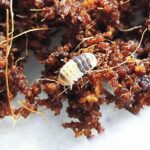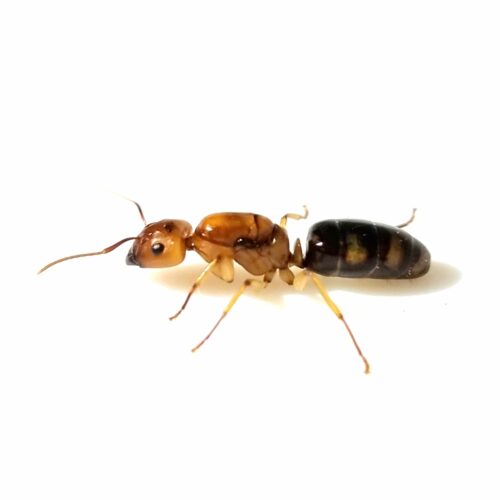
Cubaris sp. "White Shark"
5,50€ – 50,00€Price range: 5,50€ through 50,00€
Odontomachus rixosus
70,00€
Discover the fascinating Odontomachus rixosus, an exotic ant with trap-jaw mandibles and striking colors. Perfect for enthusiasts of unique species, it is active, predatory, and easy to observe. Add a wild and surprising touch to your ant farm!
SKU:
N/A
Categories: Ants, Exotic ants
Description
Technical Sheet: Odontomachus rixosus Ant
Scientific Classification
- Kingdom: Animalia
- Phylum: Arthropoda
- Class: Insecta
- Order: Hymenoptera
- Family: Formicidae
- Subfamily: Ponerinae
- Genus: Odontomachus
- Species: Odontomachus rixosus
General Characteristics
- Size:
- Workers: 8-10 mm
- Queens: 10-12 mm
- Males: 7-9 mm
- Coloration: Dark shades, typically blackish-brown with reddish highlights.
- Morphology:
- Trap-jaw mandibles capable of snapping shut rapidly to catch prey.
- Elongated body with long legs adapted for fast movement.
- Well-developed segmented antennae.
Distribution and Habitat
- Distribution: Native to Southeast Asia, found in countries like Thailand, Malaysia, Indonesia, and the Philippines.
- Habitat: Prefers tropical forests, humid areas, and soil rich in organic matter. Also adapts to disturbed environments near urban areas.
Behavior
- Diet:
- Omnivorous but primarily insectivorous. Feeds on small arthropods and occasionally sweet liquids like nectar.
- Activity:
- Mainly nocturnal but can be active during the day in shaded or highly humid conditions.
- Defense:
- Possesses a painful sting due to its functional stinger.
- Mandibles are used for both hunting and defense.
Colony
- Structure: Monogynous colonies (with a single queen).
- Size: Relatively small, ranging from 100 to 500 individuals.
- Nest: Builds nests in soft soil, decaying wood, or under rocks.
Reproduction
- Nuptial Flights: Typically occur during the humid seasons.
- Life Cycle:
- Egg → Larva → Pupa → Adult (approximately 8 weeks).
- Queen: Responsible for laying eggs and can live for several years.
Care in Captivity
- Type of Formicarium: Acrylic or soil-based formicariums with adequate humidity.
- Temperature: Between 22°C and 26°C (72°F to 79°F).
- Humidity: High, between 60% and 80%.
- Diet:
- Live prey such as crickets or fruit flies.
- Diluted honey or sugary liquids as a supplement.
- Precautions:
- Ensure the formicarium is escape-proof, as they are excellent escape artists.
- Handle with care due to their painful sting.
Interesting Facts
- Known for its mandible-closing speed, which can reach up to 50 m/s, making it one of the fastest in the animal kingdom.
- Used in scientific studies due to its predatory behavior and advanced sensory systems.
Additional information
| Options |
Queen with 15 to 25 worker ants |
|---|
Related products
Camponotus maculatus subnudus
28,00€ – 48,00€Price range: 28,00€ through 48,00€
Sold out
Select options
This product has multiple variants. The options may be chosen on the product page
Camponotus vanispinus
25,00€ – 38,00€Price range: 25,00€ through 38,00€
Sold out
Select options
This product has multiple variants. The options may be chosen on the product page
Camponotus fedtschenkoi
16,00€ – 55,00€Price range: 16,00€ through 55,00€
Sold out
Camponotus fedtschenkoi Origin and distribution: Afghanistan, Armenia, China, Iran, Kazakhstan, Kyrgyzstan, Turkey, Turkmenistan. Humidity: 50 – 70% Temperature: 24 –
Select options
This product has multiple variants. The options may be chosen on the product page
Camponotus japonicus
12,00€ – 25,00€Price range: 12,00€ through 25,00€
Sold out
Camponotus japonicus Origin and distribution: Japan, China, Democratic People’s Republic of Korea, Mongolia, Republic of Korea
Select options
This product has multiple variants. The options may be chosen on the product page
Camponotus parius
18,00€ – 28,00€Price range: 18,00€ through 28,00€
Sold out
Select options
This product has multiple variants. The options may be chosen on the product page


























